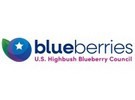The U.S. Highbush Blueberry Council (USHBC) announced details around its recently approved 2021-2015 strategic plan, which charts an ambitious course to exponentially grow the volume and value of blueberries domestically and across the globe. The plan explains how USHBC will lead demand-driving programs based on shared resources, research and insights that inspire possibilities and sustain the profitable growth of the blueberry industry – ultimately uniting industry stakeholders to work together toward making blueberries the world’s favorite fruit.
USHBC collects approximately $10 million in assessment dollars from growers and importers of record annually, and the plan addresses how the council will invest that funding to fuel increased blueberry demand. This includes expanded, measurable programmatic goals and tactics for five strategic pillars: integrated marketing communications, health and nutrition, industry services, global business development and innovation and technology. The health and nutrition pillar will be driven by USHBC’s first-ever senior director of nutrition and health research, Leslie Wada, Ph.D., RD.
“Our strategic plan is the culmination of more input from blueberry industry leaders and partners than ever before, discussed and distilled for over the better part of a year, to create a blueprint to boost blueberries worldwide,” said Kasey Cronquist, president of USHBC. “Our intent is this guiding vision will positively impact the future beyond the next five years to hopefully the next decade or two.”
USHBC embarked on the initiative in partnership with Rockland Dutton Research & Consulting, drawing on highly relevant experience working with the National Mango Board, World Bank, Beef Checkoff, Hass Avocado Board and more. The work was the most robust planning process in the USHBC’s history, with significant input from interviews with board members and industry leaders, a survey of industry stakeholders and discussions with the USHBC staff and partner agencies.
“Our exciting, forward-looking vision sets the stage for the next era of growth,” said Shelly Hartmann, chair of USHBC. “I’m proud to have a leading role as we begin executing our unifying strategy to increase demand for blueberries, while strengthening and supporting our growers and stakeholders.”
USHBC has driven demand for blueberries through comprehensive consumer promotional efforts and programming in retail, foodservice, export and food manufacturing. In 2019, 49 percent of U.S. households purchased blueberries — a 25 percent increase in annual household penetration over the previous six years. Blueberries are now on one in four menus and 76 percent of food manufacturer respondents reported using blueberries in their company’s manufactured products.
To view the 2021-2025 Strategic Plan, click here.
 For more information:
For more information:
U.S. Highbush Blueberry Council
https://ushbc.blueberry.org/
https://www.nabcblues.org/










